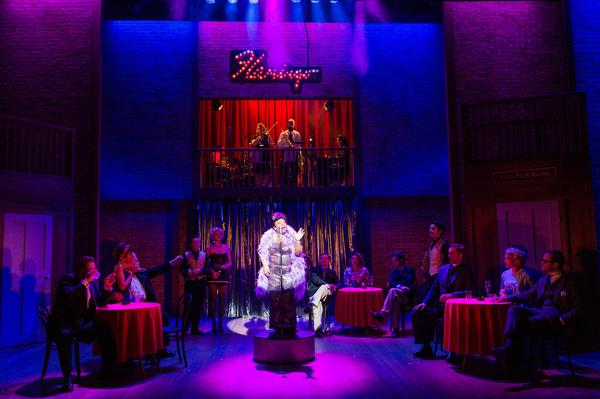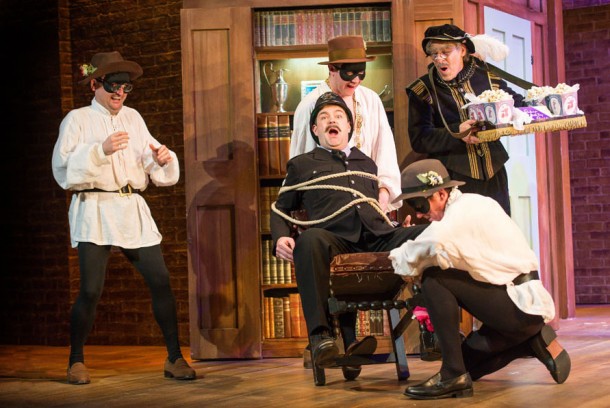The British theatre has always derived enormous, even savage pleasure from depicting the antics of its social misfits, eccentrics, and manipulators. Two recent productions, one Jacobean and the other contemporary, illustrate this beautifully. From the seventeenth century, the Royal Shakespeare has brilliantly revived a rarely performed comic masterpiece, Thomas Middleton’s A Mad World My Masters, combining a metatheatrical playfulness as complex as anything in the Elizabethan theatre with a town and country sex and money intrigue anticipating the Restoration but with a reveling in sexual innuendo that puts all but the most notorious Restoration wits to shame.
Director Sean Foley has reset the city scenes of Middleton’s play to Soho in the 1950s, whose casual Bohemianism provides a quite suitable background for these amoral doings, while the country scenes are in the more generic manor or Sir Bounteous Peersucker, whose double name (an updating of the original Bounteous Progress) suggests both his pantalone qualities and those of the benevolent country squire. Although Soho provides a visual frame—costumes, scenery and properties—the basic style of the play is the tradition of French sex farce, which is even better suited to its non-stop erotic action. The characters perform in the madcap exaggerated style of silent film comedy, and their grotesque but highly controlled poses and movements are a constant delight. Ben Deery as the cuckolded Mr. Littledick is especially effective at this, but even the smallest roles are totally in the style, right down to the aged retainer at the manor, Sponger (Michael Moreland), a total physical wreck whose entrance is always heralded by the piercing squeal of his malfunctioning hearing aid. He can barely move, but the one still functioning part of his body brings him right into line with his fellow characters.

Thomas Middleton’s A Mad World My Masters at the Barbican directed by Sean Foley. Photo credit Manuel Harlan
Alice Power’s setting is both highly flexible and ingenious. When the audience enters the theatre, it is a dimly lit Soho nightspot, with red downlights on three small round tables and a central platform with a microphone. On either side of the set is a door unit (one marked “Members Only”) topped by a small wooden balcony. Between these units, the stage is empty up to the dark back wall, which contained a small stage with curtains closed and above it a similar alcove containing a five-person band—trumpet, keyboard, bass, drums, and trombone. It took me several minutes to recognize that this was a witty evocation of an Elizabethan/Restoration stage, with the inner below and inner above at the rear and the traditional proscenium doors with small balconies above at the sides.
The various elements of this setting could be rapidly moved and revolved to form different scenic combinations, and these changes were carried out by the entire cast, quickly and efficiently whisking items on and off stage, but also embedding all this in little bits of character encounters and displays, so that each scene change became a complex ensemble number in itself.
The play contains two basic plots, a money plot and a sex plot. In the main money plot, Dick Follywit (Joe Bannister) the play’s master intriguer, unwilling to wait for his inheritance from the wealthy Peersucker, launches a series of plots, all involving disguise, to get into Peersucker’s country house and carry off some of his goods. The sex plot involves the attempts of the lust-driven Penitent Brothel (Dennis Herdman) to gain access to the all-too-willing Mrs. Littledick (Ellie Beaven). With the aid of the play’s main female intriguer, the attractive call girl Truly Kidman (originally Gullman), they finally manage to consummate their affair in a scene that is one of the evening’s highlights, and a marvelous example of the metatheatricality, which abounds in this play. We witness the wild cavortings of the lovers as a shadow play in a curtained bed, while Kidman sits nearby, pretending to be giving chaste advice to Mrs. Littledick. Mr. Littledick, in an adjoining room (actually one of the small balconies), hears all this and interprets his wife’s increasingly uncontrolled cries as outbursts of repentance aroused by the advice of Kidman. Penitent Brothel’s joy is short-lived, however. We next see him stricken with remorse, flagellating himself in his bedchamber and haunted by demonic visions including Mrs. Littledick as a voluptuous she-demon.
The climactic scene of the play is a costume ball given by Peersucker at his estate, a marvelous sequence of shifting levels of reality and illusion. To begin with, Peersucker announces that his costume must be Jacobean, returning the play visually to its historical roots. The costumes of the characters, however, add other layers to this. Of course, much humor is derived from codpieces, and Mr. Littledick belies his name by sprouting a huge erect phallus upon which he carries his wife’s purse. They are accompanied by a sepulchral Penitent Brothel, dressed in the gloomy garb of a Jacobean Puritan. The party is interrupted by the arrival of three uninvited guests who claim to be strolling players offering an entertainment. These are of course, the rogue Follywit and two friends making another raid on Peersucker.

Thomas Middleton’s A Mad World My Masters at the Barbican directed by Sean Foley. Photo credit Manuel Harlan
They gather valuables as “props” and plan to escape before the play begins, but they are trapped in the house by a constable, who attempts to arrest them. The ingenious Follywit convinces the assembled audience that he and his companions are playing thieves, and the constable, who they tie to a chair, is part of the show. The constable appeals in vain to Peersucker who, in a very modern moment, expresses shock at this new type of “experimental” theatre that seeks to involve the audience.
At last all is resolved, though not without a final plot turn, in which Follywit himself is at last outwitted and tricked into marriage with the clever Kidman, who he ingenuously takes for a virgin.
The non-stop pleasure of the production profits also from the addition of several musical numbers from the 1950s, performed as solo interludes by different actors and most notably by Linda John-Pierre, who launches the evening and helps it along with several lovely black-blues numbers. The music director was Candida Caldicot.
, Sidney E. Cohn Professor of Theatre at the City University of New York Graduate Center, is the author of many articles on theatrical theory and European theatre history, and dramatic literature. He is the 1994 recipient of the George Jean Nathan Award for dramatic criticism and the 1999 recipient of the American Society for Theatre Research Distinguished Scholar Award. His book The Haunted Stage: The Theatre as Memory Machine, which came out from University of Michigan Press in 2001, received the Callaway Prize. In 2005 he received an honorary doctorate from the University of Athens. His most recent book is The Theatres of Morocco, Algeria and Tunisia with Khalid Amine (Palgrave, 2012).
European Stages, vol. 4, no. 1 (Spring 2015)
Editorial Board:
Marvin Carlson, Senior Editor, Founder
Krystyna Illakowicz, Co-Editor
Dominika Laster, Co-Editor
Editorial Staff:
Elizabeth Hickman, Managing Editor
Bhargav Rani, Editorial Assistant
Advisory Board:
Joshua Abrams
Christopher Balme
Maria Delgado
Allen Kuharsky
Jennifer Parker-Starbuck
Magda Romańska
Laurence Senelick
Daniele Vianello
Phyllis Zatlin
Table of Contents:
- Report from Berlin by Yvonne Shafer
- Performing Protest/Protesting Performance: Golgota Picnic in Warsaw by Chris Rzonca
- A Mad World My Masters at the Barbican by Marvin Carlson
- Grief, Family, Politics, but no Passion: Ivo van Hove’s Antigone by Erik Abbott
- Not Not I: Undoing Representation with Dead Centre’s Lippy by Daniel Sack
- In the Name of Our Peasants: History and Identity in Ukrainian and Polish Contemporary Theatre by Oksana Dudko
- Performances at a Symposium: “Theatre as a Laboratory for Community Interaction” at Odin Teatret, Holstebro, Denmark, May, 2014 by Seth Baumrin
- Songs of Lear by the Polish Song of the Goat Theatre by Lauren Dubowski
- Silence, Shakespeare and the Art of Taking Sides, Report from Barcelona by Maria M. Delgado
- Little Theatres and Small Casts: Madrid Stage in October 2014 by Phyllis Zatlin
- Gobrowicz’s and Ronconi’s Pornography without Scandal by Daniele Vianello
- Majster a Margaréta in Teatro Tatro, Slovakia by Miroslav Ballay
- Remnants of the Welfare State: A Community of Humans and Other Animals on the Main Stage of the Finnish National Theatre by Outi Lahtinen
- Mnouchkine’s Macbeth at the Cartoucherie by Marvin Carlson
- Awantura Warszawska and History in the Making: Michał Zadara’s Docudrama, Warsaw Uprising Museum, August, 2011 by Krystyna Illakowicz and Chris Rzonca
Martin E. Segal Theatre Center:
Frank Hentschker, Executive Director
Marvin Carlson, Director of Publications
Rebecca Sheahan, Managing Director
©2015 by Martin E. Segal Theatre Center
The Graduate Center CUNY Graduate Center
365 Fifth Avenue
New York NY 10016




